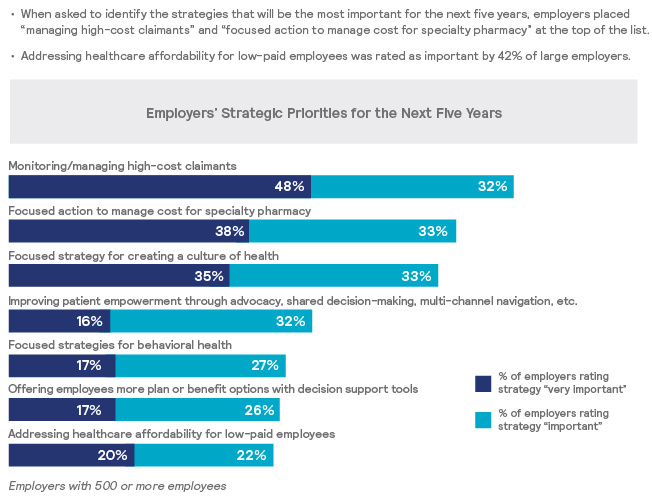 Thepercentage of employers with 20,000 or more workers that offer onlya high-deductible account-based plan fell from 22 percent to 16percent. (Photo: Shutterstock)
Thepercentage of employers with 20,000 or more workers that offer onlya high-deductible account-based plan fell from 22 percent to 16percent. (Photo: Shutterstock)
As the average total health benefit cost per employee rose 3percent this year to reach $13,046, many employers are tryingadditional health care cost management strategies so they don'thave to shift as much of the burden to workers—that is, if they canafford to absorb increasing costs, according to Mercer's National Surve my of Employer-Sponsored HealthPlans 2019.
|Mercer surveyed more than 2,500 employers and found that theaverage individual deductible in a PPO offered by large andmid-size employers rose just $10 in 2019, to $992. This jibes wellwith their priorities for the next five years, as 42 percent oflarge and mid-size employers say that "addressing health careaffordability for low-paid employees" is an important or veryimportant strategy.
|Related: Health insurance costs took a big jump foremployers and employees in 2017
|However, for small employers that typically have lessability to absorb high cost increases and fewer resources to devoteto plan management, the average deductible rose by more than$250.
|
Larger employers are also giving their workers more plan choicesother than just a high-deductible plan with a health savingsaccount, according to the survey. Indeed, the percentage ofemployers with 20,000 or more workers that offer only ahigh-deductible account-based plan fell from 22 percent to 16percent.
|"This doesn't mean HSA plans are going away, but to meet thevarious needs and budgets of today's five-generation workforce,employers are increasingly offering an array of health benefitplans," says Tracy Watts, Mercer's national leader for U.S. healthpolicy. "In fact, many employees who do the math at open enrollmentfind an HSA is a smart financial move. But for those with littlesavings or significant health issues, another plan might be abetter fit."
|Such plans are still popular: enrollment in high-deductibleaccount-based plans rose from 33 percent of all covered employeeslast year to 36 percent in 2019. These plans are offered by 71percent of large and midsize employers, up from 68 percent in 2018,and by 37 percent of small employers.
|Some of the more innovative cost-management strategies now beingimplemented offered by employers include tech-enabled programs thathelp employees manage chronic conditions or other health needs,such as musculoskeletal conditions, infertility and insomnia. In2019, 58 percent of all large and midsize employers, and 78 percentof those with 20,000 or more employees, offer one or more of suchsolutions.
|"Typically the goals of these programs are empowerment,convenience and lower costs," Watts says. "For example, a physicaltherapy app that reminds patients when to do prescribed exercises,provides instructions, and even counts reps could mean fewer tripsto a clinic, less out-of-pocket cost for the employee, and a betteroutcome."
|Telemedicine has become an important strategy to contain costs,with nearly 9 out of 10 employers now offering a program thattypically costs less than half the cost of an office visit. Thealternative is slowly catching on with workers: Last year, amongemployers offering telemedicine, on average 9 percent of eligibleemployees used telemedicine, up from 8 percent the prior year, andabout one in seven employers reported utilization of 20 percent orhigher.
|To mitigate for a shortage of behavioral health providers,particularly in rural areas, teletherapy is now offered by 42 percent ofemployers with 5,000 or more employees.
|Other cost-containment strategies include:
- Managing high-cost claims by offering workers enhanced healthadvocacy and intensive case management services, as well asprograms that make it easy for workers to seek an expert medicalopinion on a diagnosis or their treatment plan.
- Curbing the cost of specialty drugs, as spending on suchmedications rose 10.5 percent this year, compared to the 5.5percent rise in spending on all prescription drugs. One way isthrough the use of a specialty pharmacy that typically providesenhanced care management, including offering drug therapies thatcan be administered at home at less cost.
- Over half of all large and midsize employers (52 percent) andover three-fourths of those with 20,000 or more employees (78percent) now steer employees to a specialty pharmacy.
Read more:
Complete your profile to continue reading and get FREE access to BenefitsPRO, part of your ALM digital membership.
Your access to unlimited BenefitsPRO content isn’t changing.
Once you are an ALM digital member, you’ll receive:
- Critical BenefitsPRO information including cutting edge post-reform success strategies, access to educational webcasts and videos, resources from industry leaders, and informative Newsletters.
- Exclusive discounts on ALM, BenefitsPRO magazine and BenefitsPRO.com events
- Access to other award-winning ALM websites including ThinkAdvisor.com and Law.com
Already have an account? Sign In
© 2024 ALM Global, LLC, All Rights Reserved. Request academic re-use from www.copyright.com. All other uses, submit a request to [email protected]. For more information visit Asset & Logo Licensing.








